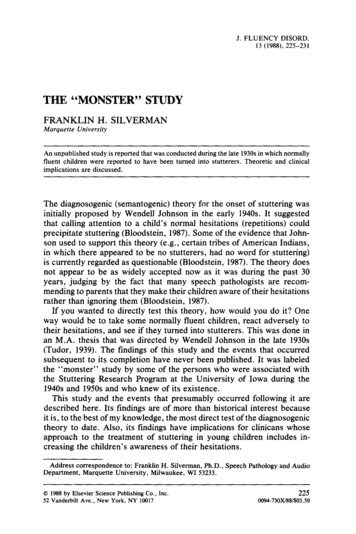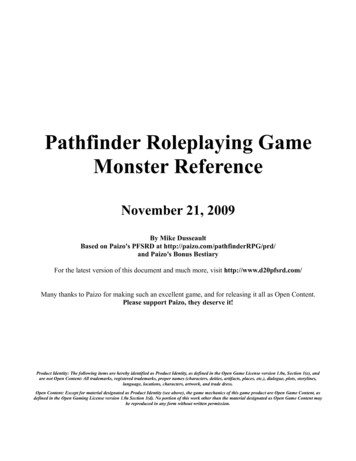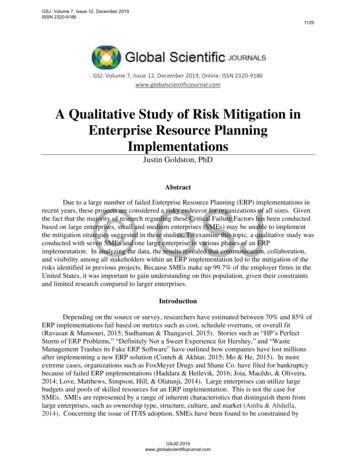
Transcription
.I. FLUENCY DISORD.13 (19881, 225-231THE “MONSTER” STUDYFRANKLIN H. SILVERMANMarquetteUniversityAn unpublished study is reported that was conducted during the late 1930s in which normallyfluent children were reported to have been turned into stutterers. Theoretic and clinicalimplications are discussed.The diagnosogenic (semantogenic) theory for the onset of stuttering wasinitially proposed by Wendell Johnson in the early 1940s. It suggestedthat calling attention to a child’s normal hesitations (repetitions) couldprecipitate stuttering (Bloodstein, 1987). Some of the evidence that Johnson used to support this theory (e.g., certain tribes of American Indians,in which there appeared to be no stutterers, had no word for stuttering)is currently regarded as questionable (Bloodstein, 1987). The theory doesnot appear to be as widely accepted now as it was during the past 30years, judging by the fact that many speech pathologists are recommending to parents that they make their children aware of their hesitationsrather than ignoring them (Bloodstein, 1987).If you wanted to directly test this theory, how would you do it? Oneway would be to take some normally fluent children, react adversely totheir hesitations, and see if they turned into stutterers. This was done inan M.A. thesis that was directed by Wendell Johnson in the late 1930s(Tudor, 1939). The findings of this study and the events that occurredsubsequent to its completion have never been published. It was labeledthe “monster” study by some of the persons who were associated withthe Stuttering Research Program at the University of Iowa during the1940s and 1950s and who knew of its existence.This study and the events that presumably occurred following it aredescribed here. Its findings are of more than historical interest becauseit is, to the best of my knowledge, the most direct test of the diagnosogenictheory to date. Also, its findings have implications for clinicans whoseapproach to the treatment of stuttering in young children includes increasing the children’s awareness of their hesitations.Address correspondence to: Franklin H. Silverman, Ph.D., Speech Pathology and AudioDepartment, Marquette University, Milwaukee, WI 53233.Q 1988by Elsevier Science Publishing Co., Inc.52 Vanderbilt Ave., New York, NY 100172250094-730X/88/ 03.50
F. H. SILVERMAN226THE DIAGNOSOGEMC(SEMANTOGEMC)THEORYJohnson wrote what he considered to be a brief, highly abstracted outlineof this theory for Hahn’s book, Stuttering: SigniJicant Theories and Therapies (1956, pp. 59-64). He stated the following:In a semantic theory of stuttering, emphasis is placed upon the self-reflexiveprocess of abstracting, the general mechanism of evaluation, by virtue ofwhich any organism reacts to its own reactions. . . . . . early infant vocalizing is characterized by a basic pattern of repetition. The infant does not say “da,” but “da, da, da.” This repetitivetendency persists into the period when the child begins to speak words andsentences and is not entirely absent from the speech of mature adults. . . .The beginning of the speech problem we call stuttering may be consideredin relation to this particular characteristic of early normal speech.Bluemel and Froeschels, particularly, have reported the observation thatstuttering in its more severe forms is preceded in the great majority of casesby what Bluemel has called “primary stuttering,” which have been described by these writers as essentially effortless, “unconscious,”simplerepetition of syllables, words, and phrases. Research dealing with the onsetand early development of stuttering has yielded findings which support andextend the observations of Bluemel and Froeschels.In fact, investigations of this problem have indicated that presumablywhat has been called “primary stuttering” is apparently the simple repetitiousness of preschool-age children. . . .The crucial point, however, is that the normal repetitions-andvariousother types of hesitant reactions that are well known to characterize childhood speech-arenot universally diagnosed as stuttering or even as “primary stuttering” by parents, teachers, physicians, or other responsibleadults. And it appears to make a significant difference whether or not theyare so diagnosed in the case of any given child-adifference, that is, in thesubsequent speech development of the child. It makes a difference becausethose who make such a diagnosis (whether or not they use the specific word“stuttering’‘-theymay make it nonverbally, in fact, in the form of bodilytensions) reach self-reflexively to their own act of making the diagnosis. Insimple terms, a mother is different from what she was before-inher evaluations of and reactions toward her child-aftershe has diagnosed him,i.e., classified him as a “stutterer,”or as a “defective,” as “having something wrong with his speech,” etc. Regarding her act of diagnosis, or classification, as a reaction to or evaluation of the child, we may say that shethen proceeds to react to that reaction, to evaluate that reaction; and thisself-reflexive process can go on indefinitely as a series of reactions to reactions to reactions, etc., or as evaluations of evaluations of evaluations,etc.As this process continues, the mother responds less and less to the actualities of the child’s behavior and more and more to her evaluations ofit-on higher and higher levels of abstraction-untilfinally she may becomequite disturbed and tense and seem almost incapable of directly observing
THE “MONSTER”STUDY227and reporting the plain facts regarding her child’s speech. The overt be-havior which this involves on the part of the mother, as well as other members of the family, teachers, relatives, etc., constitutes a pronounced changein the child’s semantic environment, the environment, that is, of evaluations, attitudes, policies, standards, verbalizations, etc. Correspondingchanges in the child’s own behavior, particularly his speech behavior, areto be expected, and they occur. These changes, as observed, are in thedirection of increased speech hesitancy and repetitiousness.As the childadopts or interiorizes the evaluations of his speech and of himself with whichhe is stimulated, he too begins to evaluate these new evaluations of his andto react to the reactions which they involve. Thus the same self-reflexiveprocess of abstracting gets under way in the child, so that he, too, comesto react less and less to the actualities of his speech and of his situationgenerally, and more and more to his evaluations of these actualities, andto his further, more abstracted, evaluations of these evaluations, etc., untilhe, too, may become quite tense and apprehensive and seem relativelydisorientated as far as the realities involved are concerned. The corresponding overt behavior is seen as the tense, anxious hesitancy with itsmany complications which we call well-developed stuttering.This, then, may be regarded as a brief, highly abstracted outline of asemantic theory of stuttering-atheory which implies stuttering is a semantogenic [italics mine] disorder with a specific diagnosogenic [italicsmine] basis. That is to say, it implies that stuttering is a disorder in whichself-reflexive evaluative or semantic reactions play a determining role, andthat the basic evaluative reaction is that which involves the act of diagnosis[italics mine].This theory assumes, therefore, that a person could be made to stutterby having somebody diagnose his normal disfluency behavior as abnormaland by indicating to him verbally or nonverbally, directly or indirectly,that he should try to speak with less hesitation.CAN DIAGNOSING NORMAL DIWLUENCY AS STUTTERINGREALLY CAUSE STUTTERING?Johnson and his students reported a great deal of data that indirectlysupport the contention that the diagnosis of stuttering can cause stuttering(e.g., Johnson et al., 1959). To directly test the contention, one wouldidentify children who are normal speakers-perhaps,even superiorspeakers-andtell them that they are hesitating (or stuttering) too muchwhen they speak and that they should try to speak without hesitating (orstuttering). If the children, after being told this, became more hesitantwhen they spoke, or if they began to stutter, the theory would besupported.Data appropriate for performing a direct test of this theory were reported in an M.A. thesis (Tudor, 1939) that was done under the direction
228F. H. SILVERMANof Professor Wendell Johnson at the University of Iowa. The study wasdone before he formulated the diagnosogenic (semantogenic) theorywhen the theory being promulgated by the Stuttering Research Programat Iowa was that stuttering was due to lack of unilateral cerebral dominance. Having been a student and a research assistant of Wendell Johnson, I find it unthinkable that he would have conducted such a study afterformulating the theory The study was never published, nor were its results widely disseminatedit is not even mentioned in Bloodstein’s AHandbook on Stuttering (1987) or in Van Riper’s The Nature of Stuttering(1982).I believe that the most likely reason why the results of this study werenot widely disseminated was that Johnson was embarrassed about themand that his colleagues, who knew of their results, did not want to embarrass him further by disseminating them. Since the theory was widelyaccepted based on the indirect evidence, they probably felt it was notnecessary to do so.I feel that it is very important that the results of the Tudor study bewidely disseminated at this time. This is because some authorities arerecommending that if a child seems excessively disfluent or seems to bebeginning to stutter, he should be encouraged to try to speak morefluently. Such recommendations would be expected to increase the probability that a child will become or remain a stutterer if the diagnosogenictheory is valid.The Tudor study was a part of a program of research in which Johnsonwas attempting to assess the validity of certain general semantics formulations (Johnson, 1946). One of these formulations was evaluative labeling-thetendency “. . . to evaluate individuals and situations according to the names we apply to them” (Johnson, 1946, p. 261). Therewere at least four other M.A. theses completed under Johnson’s directionin 1939 that were a part of this research program (Johnson, 1946, pp. 5175 18). None of the four theses dealt with stuttering.One of the primary objectives of Tudor’s study was to determinewhether labeling a person previously regarded as a normal speaker as a“stutterer”would have any effect on his or her speech fluency. Tudorscreened the children in an orphanage and selected six (who were regardedas normal speakers) to serve as subjects. Their chronological ages were5, 9, 11, 12, 12, and 15. She made the following statement to each childat the beginning of the experiment:The staff has come to the conclusion that you have a great deal of troublewith your speech. The types of interruptions which you have are very undesirable. These interruptions indicate stuttering. You have many of thesymptoms of a child who is beginning to stutter. You must try to stopyourself immediately. Use your will power. Make up your mind that you
THE “MONSTER”STUDYare going to speak without a single interruption. It’s absolutely necessarythat you do this. Do anything to keep from stuttering. Try harder to speakfluently and evenly. If you have any interruptions,stop and begin again.Take a deep breath whenever you feel you are going to stutter. Don’t everspeak unless you can do it right. You can see how [the name of a child inthe institution who stuttered rather severely] stutters, don’t you! Well, heundoubtedly started the same way you are starting. Watch your speechevery minute and try to do something to improve it. Whatever you do,speak fluently and avoid any interruptions whatsoever in your speech.(Tudor, 1939, pp. 10-11)In addition, she made the following statementstrons who interacted with these children:to the teachersand ma-The staff has come to the conclusion that these children show definite symptoms of stuttering. The types of interruptions they are having very frequently turn into stuttering. We have handled a number of cases very similarto these children. You should impress upon them the value of good speech,and that in order to have good speech one has to speak fluently. Watchtheir speech all the time very carefully and stop them when they have interruptions; stop them and have them say it over. Don’t allow them to speakunless they can say it right. They should be made very conscious of theirspeech, and also they should be given opportunities to talk so that theirmistakes can be pointed out to them. It is very important to watch for anychanges in the child’s personality, in his attitude toward his school work,in his attitude toward his playmates, etc. (Tudor, 1939, pp. 12-13)Tudor spoke toonce a month for“stutterer.”Shespeech at the endthe children and their teachers and matrons at leasta semester in order to attempt to reinforce the labelreported the following description of the children’sof the semester:All of the subjects . . . showed similar types of speech behavior during theexperimental period. A decrease in verbal output of all six subjects; that isthey were reluctant to speak and spoke only when they were urged to.Second, their rate of speaking was decreased. They spoke more slowly andwith greater exactness. They had a tendency to weigh each word beforethey said it. Third, the length of response was shorter. The two youngersubjects responded with one word whenever possible. Fourth, they weremore self-conscious. They appeared shy and embarrassed in many situations. Fifth, they accepted the fact that there was something definitelywrong with their speech. Sixth, every subject reacted to his speech interruptions in some manner. Some hung their heads: others gasped and coveredtheir mouths with their hands; others laughed with embarrassment
the “monster” study by some of the persons who were associated with the Stuttering Research Program at the University of Iowa during the 1940s and 1950s and who knew of its existence. This study and the events that presumably occurred following it are described here. Its findings are of more than historical interest because it is, to the best of my knowledge, the most direct test of the .











